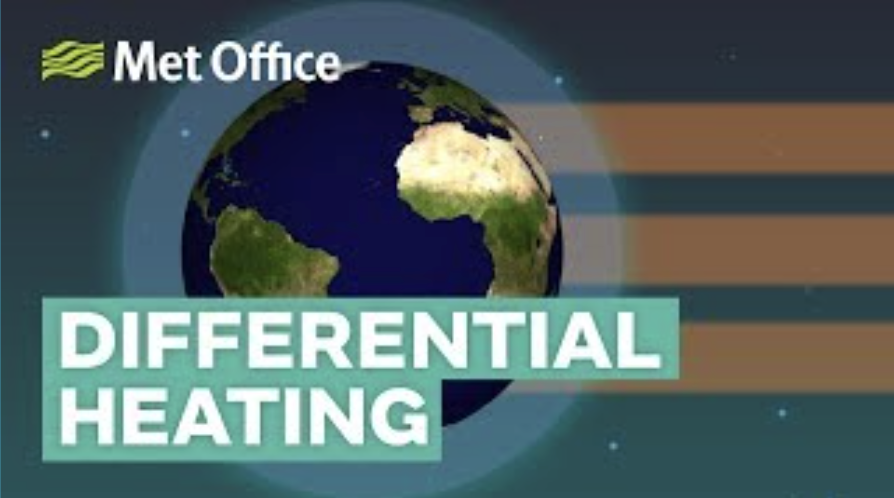Atmospheric System Unit 7 (6.1-6.4 & 8.3)
1/17
There's no tags or description
Looks like no tags are added yet.
Name | Mastery | Learn | Test | Matching | Spaced |
|---|
No study sessions yet.
18 Terms
Atmosphere
Gases form the layers surrounding the Earth, essential for supporting life and regulating climate. It consists of Nitrogen (78%), oxygen (21%), and trace gases like argon and carbon dioxide
Greenhouse gases
Are gases in the atmosphere, including carbon dioxide, methane, nitrous oxide, and fluorinated gases(eg:CFC, HFC), that trap heat and contribute to the greenhouse effect, influencing global temperatures and climate.
Albedo
The reflectivity of a surface that reflects heat into the atmosphere and space
Differential Heating
Uneven heating of Earth's surface leads to atmospheric circulation.
Solar radiation is more intense at the equator and weaker at the poles.
Hot air goes to poles while cool air sinks and returns to the equator
Each section is called a cell including Hadley(equator), Polar, and Ferrel(temperate)

Clouds
Water vapor condensed
Reflect(Albedo) Infrared Radiation from the sun, cooling earth, especially after temperature increases because more evaporation=more clouds
Trap Infrared Radiation from the Earth’s surface back into the Earth, increasing/trapping heat and increases temperature
Infrared Radiation/Solar Energy
Energy from sun. 30% of the energy is reflected back into space, and 70% is absorbed by Earth. Earth's surface emits infrared radiation, which is absorbed and re-emitted by greenhouse gases.
Electromagnetic radiation and Wavelength
Is a form of energy that is propagated through space or matter in the form of waves at speed of light
Distances between each crests which affects the property that energy can end up as
UV radiation
Is a form of electromagnetic radiation emitted by the sun that is harmful to plants and animals such as skin aging, wrinkling, skin cancer, worse plant growth, and cell and DNA damage
It is categorized into three main types based on wavelength:UVA , UVB, UVC
Ozone layer
Is a region in Earth's stratosphere that absorbs most of the Sun's ultraviolet (UV) radiation, preventing most from reaching the Earth’s surface. And are formed with O3 molecules.
Ozone depleting substances
Substances e.g., CFCs, HCFCs, halons, methyl and, bromide that destroy ozone by separating O3 into O2
Natural equilibrium disrupted → depletion
Ozone depletion allows more UVB to reach Earth → health & ecosystem impacts
Polar ozone holes appear each spring, especially over Antarctica
Kigali amendment
An international agreement to phase down the production and consumption of hydrofluoridecarbons
CFCs and HFCs
Chlorofluorocarbons and Hydrofluorocarbons which are commonly used in refrigerants, aerosols, and air cons and are greenhouse gases and ozone depleters
Montreal Protocol
An international treaty designed to protect the Earth's ozone layer by phasing out the production and consumption of ozone-depleting substances such as chlorofluorocarbons (CFCs) and hydrofluorocarbons (HFCs). And actually helped reversed damaged to ozone layer.
Acid Rain
A form of precipitation(rain, snow, fog. dust) that has been acidified(lower pH) by chemical reactions(carbonic, sulferic, and nitric acids) in the atmosphere. Are very toxic and can corrode humans, animals, stone, plants, bodies of water, etc and leaches nutrients such as calcium and magnesium from soil
Lichens
Very small plants that are very sensitive to air pollution
Ozone gas
A gas formed at ground level by a chemical reaction between air pollutants called volatile organic compounds (VOCs) and nitrogen oxides(NOx) in the presence of sunlight.
Volatile organic compounds (VOCs)
Gases released from solids or liquids that have a high vapor pressure, meaning they evaporate easily at room temperature, found in Paints, varnishes, glues. contributing to air pollution (smog, ground-level ozone, and fine particulate matter)
Climate Change Strategies
Adaptation(Manage Climate change damage), Mitigation(tackle root causes), Nature(focus on environment), Finance(to fund the 3 others)